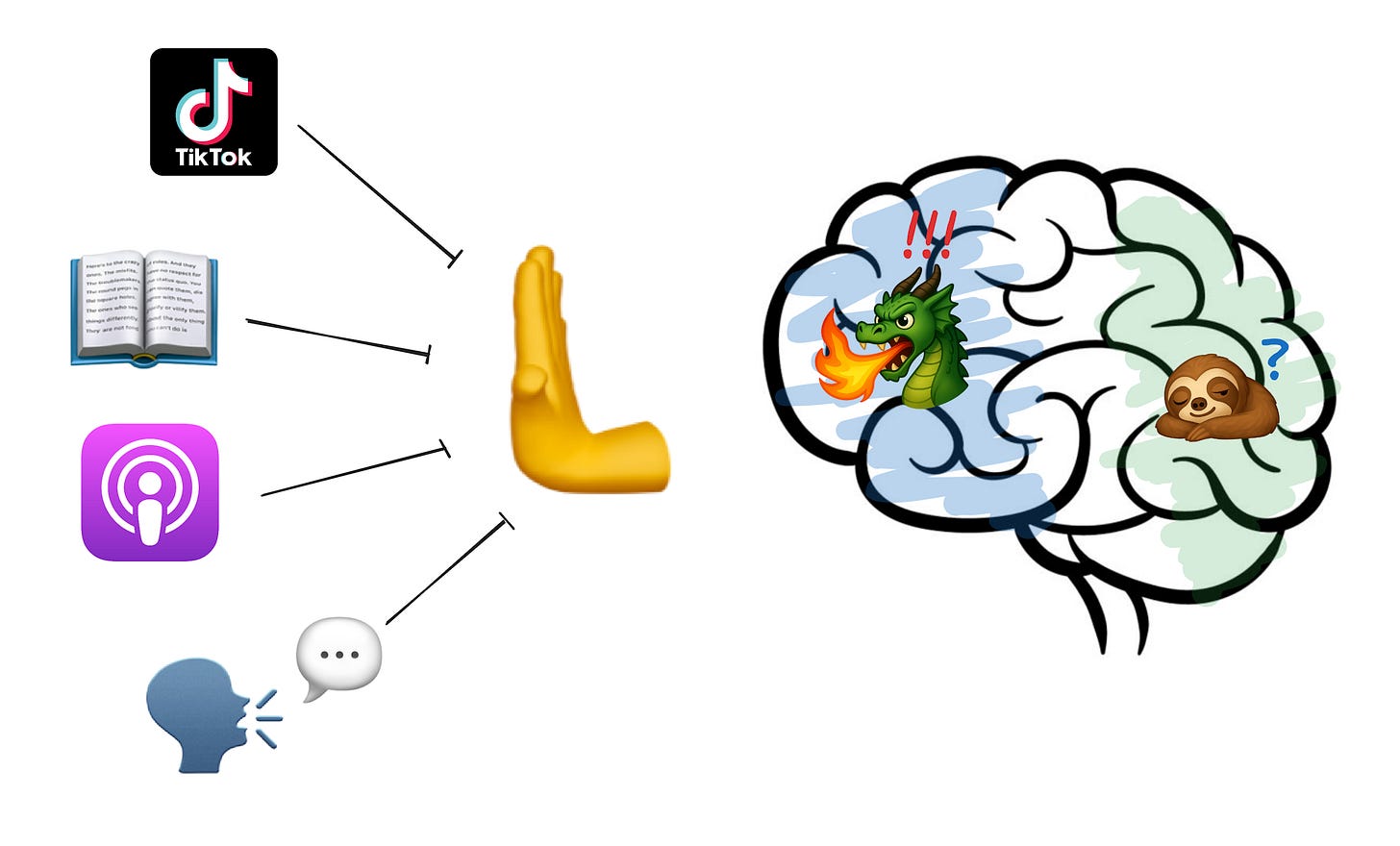Thinking is Inefficient
Humans have been trending towards generative thinking long before gen AI came about
Every six months, I go through the same cleanse. I delete all of my podcasts, audiobooks, social media, youtube backlog, substack subscriptions, and on and on until I have nothing to reach for on the subway.
Inevitably, this appears as a cycle:
Purge all media consumption
Feel an incredible freedom of mind, time, and weird creativity
Discover an insightful essay, book, or podcast
Slowly start building up my media feeds again
Feel at capacity floating in information passively without space for boredom
Go back to step 1 and purge all media consumption
There’s something to learn in this cycle that’s more than just the importance of boredom and being alone with your thoughts. Somewhere in here are clues to humanity, human agency, and societal trends that contradict how we feel about AI.
In a nutshell, we disparage the way gen AI thinks while also racing to spend more time thinking like AI. Let’s get into it!
“You sound like ChatGPT” - TheVerge
If the comments section of that article are any indication, looking, sounding, and therefore thinking like AI are some of the worst things you can possibly do. Saying something sounds like ChatGPT implies thoughtlessness, laziness, lack of originality, and conformism.
The other-ing is understandable. Something was ripped away without people’s consent to create an alien brain that is eerily familiar and yet still not human. So, lines are drawn in the sand as AI-thinking is derided and humanity is coveted behind an ever-receding goal post.
But how eerie genAI feels points to real overlap between the way humans think and how machines simulate thinking.
Generative thinking 🐉
Bear with me here, let’s simplify human thinking into two halves.
Let’s imagine that half of our thinking primarily responds to external stimulus. This half of the brain is reactive to the external world, and generates thoughts and feelings based on your corpus of memories and experiences.
Generative thinking is hungry and feels good consuming any amount of input. You can imagine that this half is dominant when we listen to podcasts, scroll TikTok, read the news, get distracted by a notification, or respond to someone’s question1.
I use the term “generative” here intentionally to map roughly to what generative AI appears to do. The key is that it is a responsive process directed by external influence.
Originative thinking 🦥
What happens when I delete all of my podcasts and social media? I have nothing left to respond to and my brain just starts making stuff up. It’s as if my generative brain must be entertained, and if there’s nothing external, then some internal process wakes up to keep the generative beast fed.
Call that internal half “originative” thinking in contrast to “generative” thinking. Originative thinking is sleepy, lazy, and biologically expensive. If it detects that the generative beast is entertained by something else, it promptly falls asleep.
Thinking - specifically originative thinking - is unnatural. We evolved to conserve cognitive energy, and our brains treat deep thought like an expensive luxury. When external stimulation is available, why would we pay the metabolic cost of firing up our internal idea generator?
This isn't speculation either. Wilson et al demonstrated that people would rather shock themselves with electricity than spend 15 minutes alone with their thoughts. The discomfort we feel in unstimulated moments is our brain's energy-saving system working as designed.
Boredom becomes the painful transition between when our generative beast exhausted its external feed and our originative sloth hasn't yet awakened. In these moments, we face a choice: endure the discomfort of waiting for deeper thinking to emerge, or hit the snooze button by reaching for our phones. The phone wins because it offers immediate relief at zero cognitive cost.
When we do resist that urge, something shifts. Cognitive scientists call this the "default mode network", the neural system that lights up when external demands quiet down. It's what lets us daydream, reflect, and connect ideas when our originative thinking finally gets a chance to feed our generative hunger from the inside.
This concept also maps roughly onto Daniel Kahneman’s “System 1” vs “System 2”, Cal Newport’s “Deep” vs “Shallow”, and Robin Hanson’s “Chasing” vs “Searching” among other concepts.
A contradiction
To summarize what we have so far: AI chatbots have overlap with human generative thinking while also representing the antithesis of human thought and creativity. If we buy this framing, then a few conclusions naturally follow:
Generative thinking is less uniquely human. It is a capability we now share with AI.
Originative thinking might be where human agency lives.
To preserve what makes us human, we should individually invest in originative thinking.
In other words: to be more human, reduce phone time and increase wall-staring time.
And thus, a contradiction: We are racing towards spending more of our time consuming generatively while disparaging generative AI2. Meanwhile, AI is racing towards becoming more agentic and originative, while not really caring either way.
[As an aside: a fun exercise - every now and then I’ll prompt various models to think deeply / recursively / daydream. It’s never as weird or disparate as what I feel happens to me when I daydream, which makes sense since it’s still generating against a prompt to explicitly daydream. I’d be curious to see what happens if an LLM is given a recursive output budget with no prompt (system or user), but I imagine it would just be the statistical average of the training data?]
Conclusion
Every six months, I go through this media cleanse, and each time I promise that this time it will stick. Over time I’ve actually come to appreciate the cycle. I dive deep, consume, update my internal corpus, and when it starts to feel passive, I blow everything up and force myself to reflect and connect the dots.
What’s important to me now is to feel in control of that balance. I have to remind myself that originative thinking is unnatural and that if I don’t fight for it proactively, it will be content sleeping forever. However, it also needs to be challenged and receive new information to create new ideas, so a media fasting cycle feels like a healthy equilibrium.
I’m still learning what it actually means to have human agency, but this exercise has gotten me one step closer. Perhaps to have agency is to paint the inside of your own mind with intention and direction rather than allowing someone (or something) else direct what you paint.
Apparently I’ve been thinking about humanity’s place in an AI world a good amount since this is the second essay on the topic. If you’re interested, the first is based on a silly talk I gave to some very anxious new grads entering the software industry:
Acknowledgements
Thanks to Michael, Zander, Emily, Dee, Baigs, and everyone else who gave their thoughts on early drafts.
I’ve been noodling on this idea for months, but really the shape of this essay came in response to Henrik Karlsson’s essays on sustained attention and cultivating new ideas.
I also recommend: Avoiding the Automation of your Heart, Just Think, and On Agency.
The timing of this essay is also influenced by a new adventure that starts for me tomorrow (I’m literally boarding the plane right now)! I’m not sure how my thinking and writing will change being inside the industry, but I will certainly continue writing, and hopefully continue publishing.
If you’d like to follow along on my continuous quest to verbalize ideas worth fixating on, feel free to join me.
“Generative” thinking is not necessarily a bad thing and there are certainly many spectrums of nuance lost in this term (eg: engagement spectrum from textbook → TikTok)! Regardless of where it is on the spectrum, generative thinking primarily creates responses to an external stimulus.
This is unfortunately proactively exploited by companies that monetize attention.






I’m an AI noob, but I can appreciate this from a psychological level. I need to practice being in sloth mode more often!
"reduce phone time and increase wall-staring time." Writing this on a sticky-note on my desk! It's funny, but also probably true. I enjoy doing mundane chores like washing dishes because I find I do my best originative thinking then!